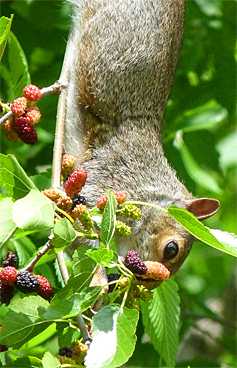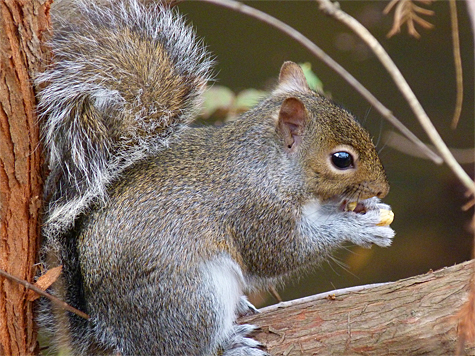
(Disclaimer to longtime blog readers: most of this post is identical to the 2012 post)
January 21st is Squirrel Appreciation Day. I learned about this day a few years ago from Michele Kloda, a member of the Museum’s research and development team. She interviewed Michael Steele, Professor of Biology and H. Fenner Chair of Research Biology, Wilkes College, Wilkes Barre, PA and learned the following amazing information about squirrels:
- Grey Squirrels maintain 2, 3, 4 or sometimes 5 nests in a given tree. Multiple nests provide multiple opportunities to hide from predators, as well as a clean home to move to once the ectoparasite (ticks, lice, fleas) load becomes too high.
- Grey Squirrels (and Blue Jays) are the primary dispersal agents for oak forest regeneration across the North Eastern deciduous forest. Without the squirrel, there would be no oaks. Squirrels also disperse some hickory, Black Walnut and Beech. They prefer Northern Red and White Oaks but will disperse Pin and Willow Oaks.
- Squirrels have evolved to hide (cache) acorns a few centimeters below the soil—the optimal location for germination. Scientists are just starting to piece together how the oaks have evolved to optimize their growth in response to squirrel behavior.
- New research examines the chemistry of acorns—their tannin and fat levels. They have more lipid/fat content near the cap and more bitter tannins at the other (embryo) end. Squirrels and birds often eat just the tasty, fatty end, and leave behind the intact embryo. It will still germinate under the right conditions. Germination changes the chemistry of the acorn and makes it less tasty.
- Scientists have discovered that squirrels respond to germination schedules of oaks. White Oaks germinate in the fall. Before this happens the squirrels eat the seeds. And a side benefit–White Oak seeds tend to spoil faster than the Red Oak seeds.
- Squirrels will cache White Oak seeds but they first bite off the embryo at the end of the acorn…then it won’t germinate or spoil for up to 6 months! (How do they know that?!?!)
- If squirrels seem busy–they are! From fall to spring, they routinely ‘tend’ their underground caches. Squirrels will move buried acorns at a rate of every 48 hours! They are constantly visiting their cached seeds to check their freshness, recall their location (they use spatial cues to find them) and eat. If a seed is close to spoiling, they will eat or discard it
- Finally, Michael’s latest research suggests that squirrels engage in deception—something that was thought to be unique to primates. Squirrels will pretend to dig a hole and pound down the earth as if burying an acorn, but then carry that acorn to a different location. They may engage in this pretend scenario several times with the same seed. The behavior is thought to throw off potential pilferers.
If you have any squirrel appreciation to spread please share. Check out Ranger Greg’s blog posts about squirrels to learn more about them:
A Tasty Snack for Wolves (Squirrel lovers may not want to read this post)

And of course, National Squirrel Appreciation Day was founded in Asheville, NC–a homegrown celebration of our backyard biodiversity!